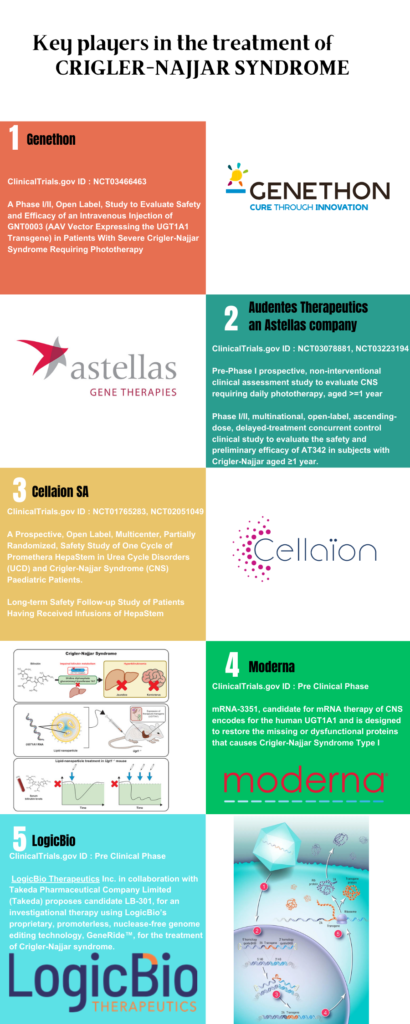Crigler-Najjar Syndrome (CNS) is often characterized by jaundice at birth leading to kernicterus in which the accumulated unconjugated bilirubin reaches the brain and affects the nervous system. With the elevated unconjugated bilirubin levels, the primary therapeutic goal is to reduce the blood bilirubin to prevent kernicterus development. Phenobarbital is often given to patients with type II CNS, while phototherapy is saved for more severe situations. However, as patients get older, phototherapy becomes less effective, and other options like LED technology are hard to come by. Plasmapheresis, a process where blood components are taken out, separated, and put back in, might also be considered. Liver transplantation is the main treatment, yet its expense and accessibility are a challenge accompanied by risks like organ rejection and immunosuppressant dependency. New research is delving into promising paths like enzyme replacement therapy (ERT), gene replacement therapy, and stem cell transplantation.
Stem cell and regenerative medicine hold significant promise for the treatment of CNS. This offers a potential avenue for addressing the root cause of the disease by replacing or repairing damaged liver cells with the help of hepatic progenitor cells by transplanting these into the liver of CNS patients, with the expectation of restoration of bilirubin metabolism. Additionally, induced pluripotent stem cells (iPSCs), derived from the patient’s cells, and reprogrammed into liver-like cells, offer a personalized treatment approach that may reduce the risk of immune rejection. In a recent collaboration between Moderna and Institute for Life Changing medicines, mRNA-3351 encoding human UGT1A1 has been allotted a therapeutic pre-clinical candidate to treat type I CNS.
The latest news in the field is the findings from a Genethon-sponsored European gene therapy clinical trial that have been published in The New England Journal of Medicine. The trial demonstrates the safety and effectiveness of gene therapy in restoring expression of the UGT1A1 gene, thereby reducing bilirubin levels to below toxic thresholds in patients. The outcomes of dosage-escalation segment report of phase I/II investigation assessing the safety and effectiveness of a single intravenous administration of an adeno-associated virus (AAV) serotype 8 vector carrying UGT1A1 in individuals diagnosed with Crigler–Najjar syndrome undergoing phototherapy. Five patients were administered a single dose of the gene construct (GNT0003): two received 2×1012 vector genomes (vg) per kilogram of body weight, and three received 5×1012 vg per kilogram. The primary objective encompassed safety and efficacy assessments, with efficacy defined as a serum bilirubin level of 300 μmol per liter or lower, measured at 17 weeks, one week following phototherapy cessation. By week 16, patients receiving the lower dose of GNT0003 exhibited serum bilirubin levels surpassing 300 μmol per liter. Conversely, patients receiving the higher dose had bilirubin levels below 300 μmol per liter without phototherapy after the study. Despite its potential as a curative solution for Crigler-Najjar Syndrome (CNS), uncertainties persist regarding the long-term effectiveness and safety of gene therapy. The duration of efficacy following a single infusion of an adeno-associated virus (AAV) transgene vector remains unclear.

Figure 1: Prominent drug developing companies for CNS. Image Source: Malini Gupta
Competition within the market for Crigler-Najjar Syndrome drugs is intense, featuring prominent contenders as depicted in Figure 1. The global CNS market is growing with a CAGR of 5% in the period of 2022-2029 as analyzed by Data Bridge Market Research Analysis.
Dr. Malini Gupta, Ph.D.
Sources:



